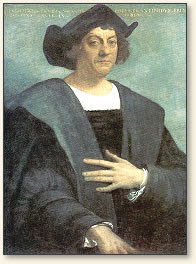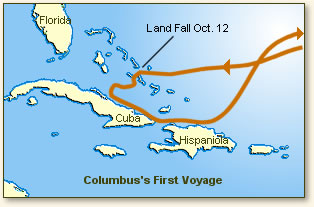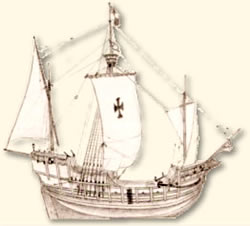|
Christopher Columbus
Discovers America, 1492
Columbus led his three ships - the Nina, the Pinta and the Santa Maria - out of  the Spanish port of Palos on August 3, 1492. His objective was to sail west until he reached Asia (the Indies) where the riches of gold, pearls and spice awaited. His first stop was the Canary Islands where the lack of wind left his expedition becalmed until September 6. the Spanish port of Palos on August 3, 1492. His objective was to sail west until he reached Asia (the Indies) where the riches of gold, pearls and spice awaited. His first stop was the Canary Islands where the lack of wind left his expedition becalmed until September 6.
Once underway, Columbus benefited from calm seas and steady winds that pushed him steadily westward (Columbus had discovered the southern "Trades" that in the future would fuel the sailing ships carrying goods to the New World). However, the trip was long, longer than anticipated by either Columbus or his crew. In order to mollify his crew's apprehensions, Columbus kept two sets of logs: one showing the true distance traveled each day and one showing a lesser distance. The first log was kept secret. The latter log quieted the crew's anxiety by under-reporting the true distance they had traveled from their homeland.
This deception had only a temporary effect; by October 10 the crew's apprehension had increased to the point of near mutiny. Columbus headed off disaster by promising his crew that if land was not sighted in two days, they would return home. The next day land was discovered.
Columbus's journal of his first voyage to America has been lost. However, we do have an accurate abstract of the journal written by Bartolome de las Casas in the 1530s. Las Casas was an historian and Columbus's biographer who had access to the original journal of the voyage. We join Columbus's account as his expedition approaches the islands of the Bahamas. Throughout the account, Columbus refers to himself in the third person as the "Admiral":
"Thursday October 11
The course was W.S.W., and there was more sea than there had been during the whole of the voyage. They saw sand-pipers, and a green reed near the ship. Those of the caravel Pinta saw a cane and a pole, and they took up another small pole which appeared to have been worked with iron; also another bit of cane, a land-plant, and a small board. The crew of the caravel Niņa also saw signs of land, and a small branch covered with berries. Everyone breathed afresh and rejoiced at these signs. The run until sunset was 27 leagues.
After sunset the Admiral returned to his original west course, and they went along at the rate of 12 miles an hour. Up to two  hours after midnight they had gone 90 miles, equal to 22 1/2 leagues. As the caravel Pinta was a better sailer, and went ahead of the Admiral, she found the land, and made the signals ordered by the Admiral. The land was first seen by a sailor named Rodrigo de Triana. But the Admiral, at ten o'clock, being on the castle of the poop, saw a light, though it was so uncertain that he could not affirm it was land. He called Pero Gutierrez, a gentleman of the King's bedchamber, and said that there seemed to be a light, and that he should look at it. He did so, and saw it. The Admiral said the same to Rodrigo Sanchez of Segovia, whom the King and Queen had sent with the fleet as inspector, but he could see nothing, because he was not in a place whence anything could be seen. hours after midnight they had gone 90 miles, equal to 22 1/2 leagues. As the caravel Pinta was a better sailer, and went ahead of the Admiral, she found the land, and made the signals ordered by the Admiral. The land was first seen by a sailor named Rodrigo de Triana. But the Admiral, at ten o'clock, being on the castle of the poop, saw a light, though it was so uncertain that he could not affirm it was land. He called Pero Gutierrez, a gentleman of the King's bedchamber, and said that there seemed to be a light, and that he should look at it. He did so, and saw it. The Admiral said the same to Rodrigo Sanchez of Segovia, whom the King and Queen had sent with the fleet as inspector, but he could see nothing, because he was not in a place whence anything could be seen.
After the Admiral had spoken he saw the light once or twice, and it was like a wax candle rising and failing. It seemed to few to be an indication of land; but the Admiral made certain that land was close. When they said the Salve, (Salve Regina) which all the sailors were accustomed to sing in their way, the Admiral asked and admonished the men to keep a good look-out on the forecastle, and to watch well for land; and to him who should first cry out that he saw land, he would give a silk doublet, besides the other rewards promised by the Sovereigns, which were 10,000 maravedis to him who should first saw it. At two hours after midnight the land was sighted at a distance of two leagues."
Columbus ordered the three ships to halt and wait for daylight before venturing further. His journal continues:
"Friday October 12
 |
The Santa Maria, Columbus's flagship
|
The vessels were hove to, waiting for daylight; and on Friday they arrived at a small island of the Lucayos, called, in the language of the Indians, Guanahani. Presently they saw naked people. The Admiral went on shore in the armed boat, and Martin Alonso Pinzon, and Vicente Yanez, his brother, who was captain of the Niņa. The Admiral took the royal standard, and the captains went with two banners of the green cross, which the Admiral took in all the ships as a sign, with an F and a Y and a crown over each letter, one on one side of the cross and the other on the other.
Having landed, they saw trees very green, and much water, and fruits of diverse kinds. The Admiral called to the two captains, and to the others who leaped on shore, and to Rodrigo Escovedo, secretary of the whole fleet, and to Rodrigo Sanchez of Segovia, and said that they should bear faithful testimony that he, in presence of all, had taken, as he now took, possession of the said island for the King and for the Queen his Lords, making the declarations that are required, as is now largely set forth in the testimonies which were then made in writing."
Shortly after landing, many of the island's inhabitants assembled on the beach and Columbus gave them gifts of red hats and beads. The natives reciprocated with gifts of parrots, cotton and other goods. In describing the natives, Columbus wrote: "They go as naked as when their mothers bore them, and so do the women, although I did not see more than one girl. They are very well made, with very handsome bodies, and very good countenances."
References:
Columbus's journal appears in Olson, Julius, The Northmen,
Columbus and Cabot, 985-1503 (1926); Dyson, John, Columbus: for Gold, God, and
Glory (1991); Morrison, Samuel Eliot, Admiral of the Ocean Sea (1942);
How To Cite This Article:
"Christopher Columbus Discovers America, 1492," EyeWitness to History, www.eyewitnesstohistory.com (2004).
|






